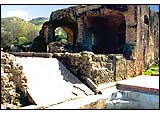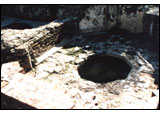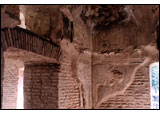If one continues
along the Grand Trunk Road west of Lahore, past the modern capital
of Islamabad and the ancient Buddhist monastery of Taxila, one
passes by an extraordinary Mughal garden near the town of Hasan
Abdal, at a village known as "Wah"–sometimes translated
as "Wow!"–purportedly the first word uttered by
Akbar, the third ruler of the Mughal dynasty, upon seeing the
idyllic setting and clear, rushing waters.
|
|
 |
| |
 |
| |
The
Cypress-Lined
Water Axis |
| |
| |
The
Remains of a
Hammam (Bath) |
 |
| |
Interior
of a Baradari
(Open Pavilion) |
 |
| |
|

The garden is fed by clear, cool springs that collect in a large
square tank on its upper terrace. The water originally flowed
through a baradari and two flanking pavilions, one of which had
elaborate bath chambers (hammam), over an inclined cascade
that was decorated in a typically Mughal black-and-yellow marble
chevron pattern. The water continued along a cypress-lined garden
axis, through a central water tank and platform, and ultimately
through the main entrance gate of the garden.

The
Pakistan Department of Archaeology has excavated and restored
part of the garden, while researchers such as Shahid Rajput (1996)
have documented its history, spatial structure, and features.
Catherine Asher (1996) has emphasized the possible roles and meanings
of the Hindu Rajput noble Raja Man Singh's patronage at the site.
Philippa Vaughn (1995) has interpreted the garden as a unique
surviving example of a Manzil Bagh, where traveling nobles
would halt on their journey. Wescoat (1990) suggests it may reflect
the influence of contemporary Mughal garden design in Kashmir,
as it lay on an important road to that province and had a similar
spring-fed, terraced layout. Abdul Rehman (1997) provides a detailed
account of the garden within the natural and built environment
of Hasan Abdal. And in view of this Manzil garden's beauty and
historical significance, it seems likely to draw many more travelers,
researchers, and conservationists in the years to come.
Asher,
C. 1996. "Gardens of the Nobility: Raja Man Singh and the
Bagh-I-Wah." In The Mughal Garden, Ed. M. Hussain,
A. Rehman, and J. Wescoat. Lahore: Ferozsons, pp. 61-72.
Rajput,
S. 1996. "The Mughal garden "Wah" near Hasanabdal:
Source Material, Report of Excavations of 1993-94 and New Discoveries."
In The Mughal Garden, Ed. M. Hussain, A. Rehman, and J.
Wescoat. Lahore: Ferozsons, pp. 73-88.
Rehman,
A. 1997. Historic Towns of Punjab: Ancient and Medieval Period.
Lahore: Ferozsons, pp. 217-36.
Vaughn,
P. 1995. "The Mughal Garden at Hasan Abdal: A Unique Surviving
Example of a 'Manzil' Bagh." South Asia Research 15:
241ff.
Wescoat,
J. L. Jr. 1990. "The Geographic Meaning of Shalamar Garden."
In Shalamar Garden Lahore: Landscape, Form and Meaning.
Karachi: Pakistan Department of Archaeology, pp. 45-58. |
|